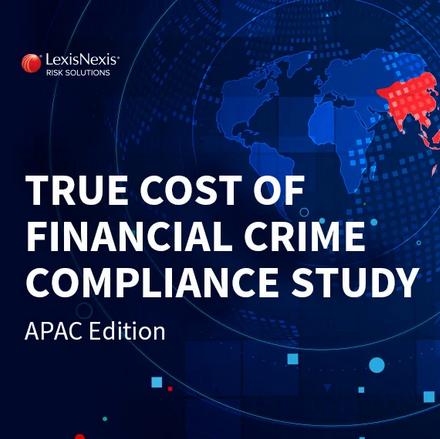
Australian financial services firms to spend more than US$2.54B on financial crime compliance in 2022: LexisNexis Risk Solutions
LexisNexis® Risk Solutions today released its first Australian edition of the LexisNexis True Cost of Compliance™ Study. The study revealed that Australian financial services companies are expected to spend more than a collective US$2.54 billion (AUD $3.6 billion) on financial crime compliance, driven by the increased compliance staff hiring and the complexity of preventing financial crime.
The study, which surveyed 50 decision makers in the Australian market between December 2021 and February 2022 and is part of a larger Asia-Pacific regional study, found that the exposure of Australian financial firms to financial crimes has increased in the past 18 to 24 months. Eighty percent (80%) of Australian compliance professionals in financial firms ranked money laundering as the highest risk within their compliance operations. Respondents also indicated that third party professional service providers, such as accountants and lawyers, played a role in facilitating money mules to launder proceeds of predicate crimes.
Increasing anti-money laundering (AML) regulations, evolving criminal threats and ongoing impacts of the pandemic have driven higher financial crime compliance costs to an estimated U.S. $19.2 million (AUD $27.6 million) for larger Australian financial institutions and has led to increased investments in both labor and technology.
Key findings from the 2022 True Cost of Compliance Study – The Australian Edition:
- Labor As a Driver of Increased Compliance Costs – More than two-thirds of financial institutions surveyed indicated they had increased compliance staff since 2019. Labor and training accounted for 54% of average compliance costs while technology, including adding or maintaining networking or systems that support remote working during the pandemic, accounted for 41% of costs.
- Using Technology to Solve Compliance Challenges – Large financial institutions that invested in technology solutions to support financial crime compliance efforts experienced less severe impacts on cost and compliance operations (almost U.S. $17.5M or AUD $25 million per annum), greater efficiencies and fewer pandemic-related challenges. Those that spent less than the industry average on technology spent an average of U.S $18.9M (AUD $28.7 million) on annual financial crime compliance costs.
- Increased Exposure to a Range of Financial Crimes – Money mules and financial crimes involving digital payments are increased and contributed largely to rising financial crime compliance costs. Respondents reported increased exposure to trade-based money laundering (TBML), third-party fraud (supply chain corruption, professional advisors), proceeds of trafficking and the criminal use of new technologies and methods, including cryptocurrency.
“Ecommerce and retail were ranked highest as being of most risk for money laundering by Australian financial institutions,” said David Haynes, vice president at Lexis Nexis Risk Solutions. “Amidst the growing regulatory pressures and evolving threats, retailers and ecommerce merchants should be prepared for increased costs brought by the digital transformation.”
Download a copy of the True Cost of Financial Crime Compliance Study – Australia Edition.


